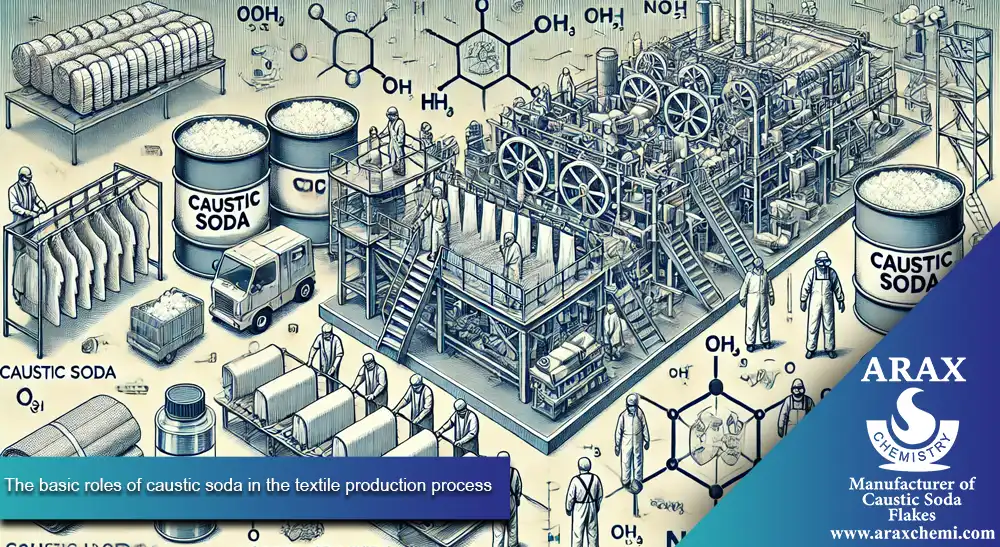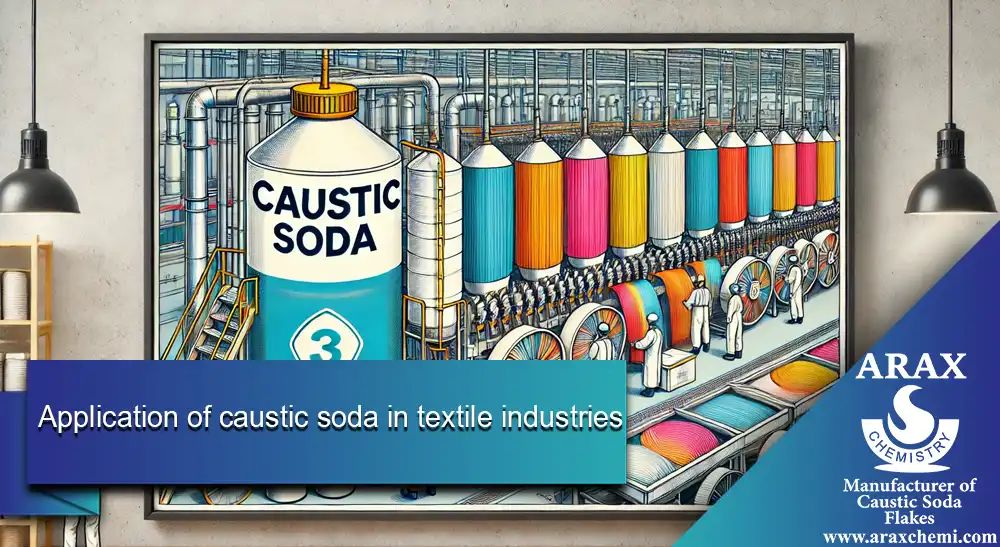Caustic soda, also known as sodium hydroxide, is a versatile and crucial product in the textile industry, playing an essential role in various stages of production. From the initial treatment of raw materials to the enhancement of finished products, caustic soda significantly improves textile quality. This article explores the chemical properties, roles, effects, and best practices for using caustic soda in the textile industry. Join Arax Chemical for a detailed exploration.
A Brief History of the Textile Industry and the Introduction of Caustic Soda
The textile industry has a long and rich history and continues to be a vital sector for many economies worldwide. It encompasses several segments, including the production of raw materials like cotton, silk, wool, and synthetic fibers, as well as the manufacture of finished goods such as clothing, home textiles, and industrial fabrics. The textile production process generally falls into three key categories:
- Pre-treatment
- Dyeing and Printing
- Finishing
In the pre-treatment stage, raw fibers are processed to remove impurities and prepare them for dyeing. During the dyeing and printing phase, colors and patterns are applied to textiles. The finishing stage involves processing the fabrics to achieve specific properties like softness, wrinkle resistance, and durability.
Over the centuries, the textile industry has evolved significantly, with technological advances improving production efficiency and product quality, variety, and durability. Among the critical chemicals used in this industry, caustic soda stands out for its wide range of unique benefits across different stages of textile production.
Key Roles of Caustic Soda in Textile Manufacturing
Caustic soda’s alkaline nature and high reactivity make it an indispensable chemical in the textile industry. It plays critical roles in several processes, including:

- Scouring and Cleaning: During pre-treatment, both natural and synthetic raw fibers undergo scouring. Caustic soda is used to remove impurities such as grease and wax, improving the fibers’ ability to absorb water and dye.
- Mercerization: In this process, fabrics are treated with a concentrated caustic soda solution under high tension, resulting in enhanced luster, strength, and color retention.
- Dyeing: Caustic soda is also used to dissolve specific types of dyes, such as sulfur dyes, making it essential in the dyeing process.
- Desizing: After dyeing and printing, textiles often retain sizing agents used during weaving. A diluted caustic soda solution is applied to remove these agents, known as desizing.
- Finishing: In the final stages, caustic soda helps enhance fabric properties like wrinkle resistance and overall durability.
Impact of Caustic Soda on Leading Textile Industries Worldwide
Caustic soda has a significant impact on several leading global textile industries, including:
Bangladesh’s Cotton Textile Industry: Bangladesh, a global leader in textiles, uses caustic soda in the mercerization process, greatly enhancing the quality of its cotton textiles and making them competitive in international markets.
Indian Denim Industry: Caustic soda plays a crucial role in India’s denim industry, improving thread preparation through de-sizing and enhancing the dyeing and finishing processes, resulting in better color and fabric quality.
Turkish Home Textile Sector: Renowned for producing high-quality towels, clothing, and linens, Turkey uses caustic soda to improve the overall quality of its home textiles, boosting the country’s textile sector globally.
Chinese Silk Industry: In China, caustic soda is vital for processing raw silk. It helps remove sericin, the protective gum around silk fibers, thereby improving the softness and sheen of the fabric.
Environmental Impact of Caustic Soda Use in Textiles
While caustic soda is indispensable in textile production, its environmental impact cannot be overlooked. In today’s environmentally conscious world, manufacturers must work to reduce the adverse effects of their processes. Caustic soda itself does not accumulate in the air, water, or soil, but its high pH and corrosive nature can disrupt aquatic ecosystems by altering water pH levels. Additionally, hydrogen gas, produced during the chlor-alkali process, poses environmental risks. To mitigate these concerns, textile producers and caustic soda manufacturers typically implement the following measures:
- Wastewater Treatment: Effluent treatment plants in the textile industry neutralize the high pH of wastewater before discharge, ensuring harmful substances are removed.
- Recycling: Some textile factories have systems in place to recycle and reuse caustic soda, reducing chemical waste and transportation costs.
- Improved Production Processes: Modern technologies, such as membrane cell techniques, help reduce the environmental impact of the chlor-alkali process.
The Future of Caustic Soda in the Textile Industry
For decades, caustic soda has been integral to textile manufacturing. However, as the industry evolves with technological advancements, the use of caustic soda is also expected to adapt. The growing emphasis on reducing environmental impacts is leading to innovations, such as the recycling of used caustic soda and the development of sustainable alternatives. Furthermore, advancements in textile technologies, like nanotechnology, could further enhance the efficiency and effectiveness of caustic soda in future production processes.
Conclusion
This article has explored the role of caustic soda in the textile industry from raw material treatment to final product enhancement. Sodium hydroxide (caustic soda) remains an essential chemical agent in processes like scouring, desizing, mercerization, and finishing. When purchasing sodium hydroxide for textile use, it is essential to consider factors such as brand, form, cost, certifications, environmental impact, and the supplier’s reliability. Arax Chemical, with decades of experience and a skilled workforce, is proud to offer high-quality caustic soda. For commercial-scale purchases, feel free to contact our specialists throughout the week.
FAQs
- How is caustic soda used in textile production?
Caustic soda is primarily used in mercerization, a process that increases fabric strength, luster, and dye affinity by causing the fibers to swell. It is also employed in other stages of textile production. - What is the process of treating cotton with caustic soda?
Cotton is treated with caustic soda to remove impurities. The treatment enhances the strength, dye absorption, and smoothness of cotton fabrics or yarns. - What are the benefits of using caustic soda in the textile industry?
Caustic soda is essential for processes like bleaching, cleaning, and mercerizing cotton. Its affordability and reactivity have a direct impact on the quality and cost of the final textile products.

